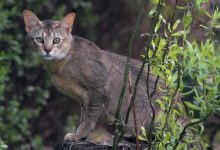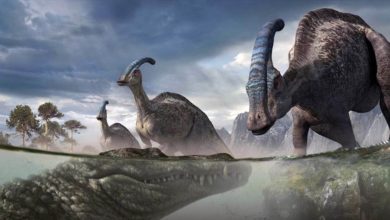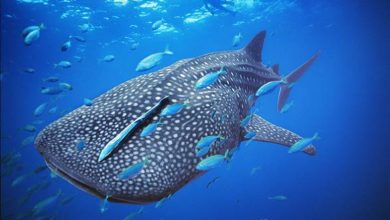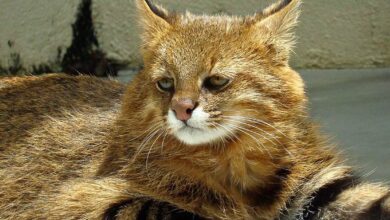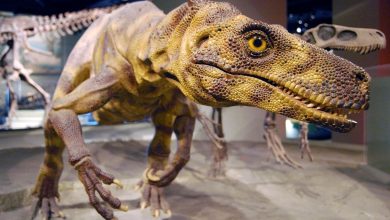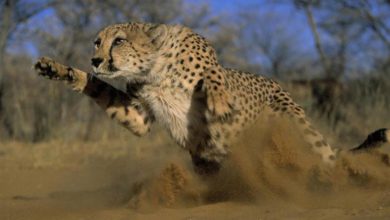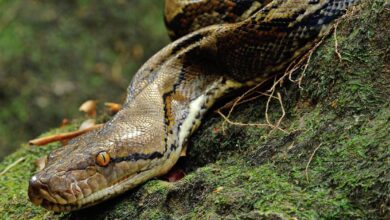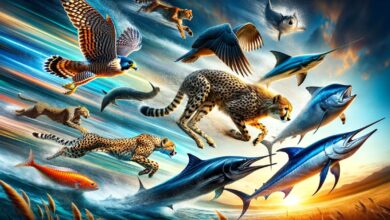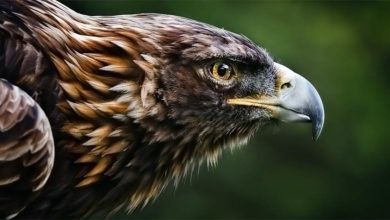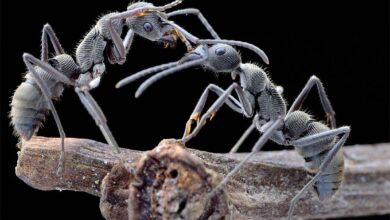Gelada (Theropithecus gelada)
This species successfully rejects the stereotype of monkeys as forest animals that love to live on trees. Geladas with their behavior, more than monkeys, resemble…. sheep. It is time to get to know another amazing animal that only a few have heard about, and only the chosen ones have seen it. Enjoy a trip to the mountains of Africa.
Classification
- Class: Mammalia
- Order: Primates
- Family: Cercopithecidae
- Genus: Theropithecus
- Species: Theropithecus gelada
Within the species, there have been classified two subspecies:
- Northern gelada (Theropithecus gelada gelada)
- Eastern gelada, southern gelada or Heuglin’s gelada (Theropithecus gelada obscurus)

Occurrence and habitat
These monkeys can be encountered only in the Ethiopian Highlands. The largest population resides in the Semien Mountains.
It occurs at 1800 – 4400 m (1.12 – 2.73 mi) below the sea level. It sleeps on the rocks, feeding on the meadows full of deep ravines. These areas are located at a considerable distance from forest formations, however, they are covered with dense bushes.
The areas where the gelada lives are also characterized by relatively low temperatures compared to the lowland dry areas. However, since there is no dry season in the Ethiopian Highland and in consequence, there is not a seasonal lack of food, the monkey has access to food throughout the year. However, it must sometimes cope with the temperatures below freezing during the dry season and also with the hailstorm during the rainy season.
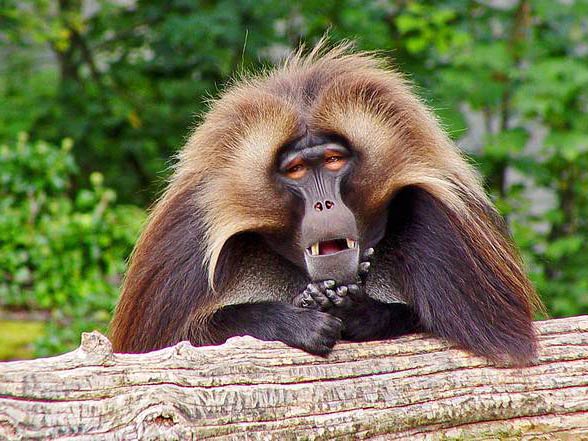
Characteristic
Appearance
Within the genus, there is a sexual dimorphism when it comes to the size: males weigh 18.5 kg (40.8 lb) on average and females can reach 11 kg (24 lb). The length of the body in both sexes is similar, ranging from 50 to 75 cm (19.7 – 29.5 in).
Gelada is a large and heavy-built monkey. Its large body is covered with thick dark brown fur, the face is graphite, and the eyelids are brighter. The hands and the feet are almost black, and on the rump, there is a long hairy tail with a pinch of hair on the tip. Mature males have a long, thick coat. Both in males and females, there is an hourglass-shaped bare skin on the chest. In males it has a bright red color and is surrounded by light hair, it is much harder to notice in females. During puberty, this patch brightens and fills with liquid to form a kind of a large bladder. It is believed that this phenomenon is equivalent to the baboons’ buttocks augmentation during the reproductive period.
As the gelada lives exclusively on the ground, it has been equipped with several important adaptive features. One of the most important is strong fingers adapted to pull grass and narrow, small incisors to chew the plants. The monkey also moves in a characteristic way – while feeding it does a squat on its two hind legs and it shuffles in the grass, tearing it with its forelegs. The monkey does not change the body posture during eating, and thanks to the developed buttocks, it can sit on the ground and looking for food for a long time.
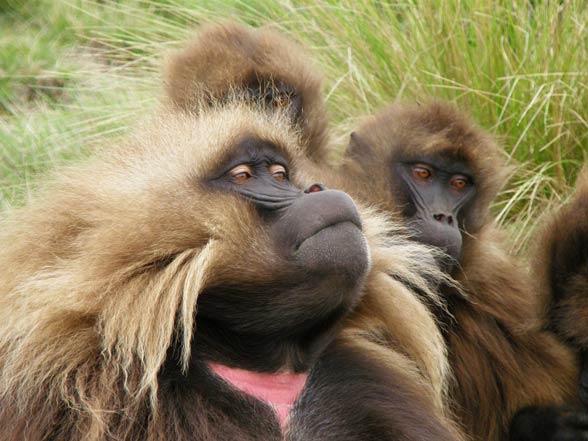
Diet
The gelada is the only representative of the primates, which look for the food on the meadows, and feeds almost exclusively on grass (it accounts for about 90% of its diet). It eats both leaves and grass seeds, especially the latter. It also happens to eat flowers, roots, and rhizomes if they are available in the area. It digs out the underground parts of the plant with its strong hands. It rarely consumes insects, usually when it is easy to catch them. In the dry season, it eats more herbs than the grass.
Suggesting the above description, it is easy to notice that geladas behave more like ungulate mammals than primates.
It is active mainly during the day (at night it sleeps on the rock shelves). At sunrise, it leaves the den and head to the plateau in order to get food and meet other monkeys. In the afternoon, its social behaviors gradually fade away in favor of intensive feeding which is connected to frequent travels. In the evening, after returning to the den, its interest in other members of the flock increases.

Lifestyle
Communication
Adults use many noises to make contact with other geladas. They often show subjection or strength, try to persuade another individual to behave in a particular way, or they show aggression and try to defend themselves. They often sit down in a circle and talk to each other. The degree of intimacy between individuals results to some extent from their social status.
In addition to the verbal communication, gelada uses gesticulation and facial expressions. In emergency situations, they curl their lips in order to present a set of teeth and tighten the skin on the forehead to show clear lids.
Social structure
Geladas live in complex, multi-layered communities, resembling the flocks created by the baboons. The smallest and the most basic group of geladas are family / reproductive groups consisting of 1-12 females, their offspring, and 1-4 males. Males also form bachelor groups consisting of about 15 individuals. Apart from these groups, there are as well large herds formed from about 30 individuals. Such herds can count about 60 monkeys, often from different groups. These are not permanent groups – they function for a short time. Large communities of geladas consist of 1-4 groups whose feeding grounds overlap.
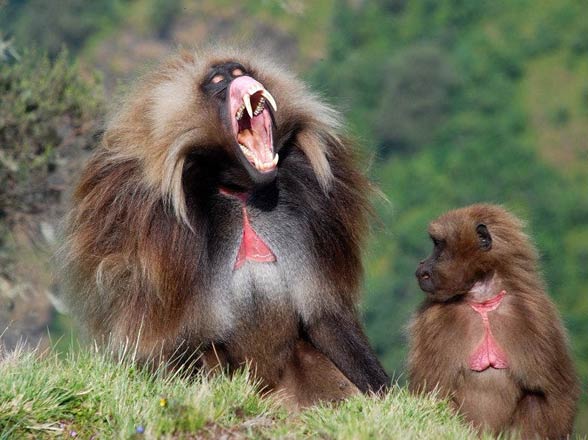
Females
Females from the family groups seem to be close to each other. During the reproductive season, they can copulate with three different males from their group. Among females, there occurs mostly social interaction such as mutual grooming. As far as the reproduction is concerned, there is a hierarchy among the females – those, which are higher in the hierarchy, are more successful and can give birth to more juveniles. Females from a similar social level are the most closely related. Young females remain in their parent group for the rest of their lives. It happens rarely that they leave their family groups. The aggression within the same reproductive group is not common; it is rather directed at “strangers”.
Males
Males can stay in the family group for 4-5 years, and then they have to leave. Nonetheless, it is believed that they often return to their family groups in order to take them over. They can do this through a direct attack and a fight or by joining the group and attracting females. This means that the females have the biggest influence on the dominant male. When a rival appears, females may support their former master or oppose him. The dominant male maintains its position not through aggression, but through mutual care. The mark of acceptation of the females by the male is to present its grace. However, not all the subordinates can copulate with the dominant male.

Often one female has one partner, forming a monogamous relationship with him. If such a male tries to enter into relationships with other females, he meets with indifference.
Groups of males
Most male groups consist of several juveniles and one adult, which is the leader. In such a group, males may spend 2-4 years before joining a group of females in which they can reproduce. Usually, males from these communities are aggressive towards other groups, both mixed and consisting exclusively of males. However, it happens rarely within the group. There is no social hierarchy, but the bonds between individuals are strong.
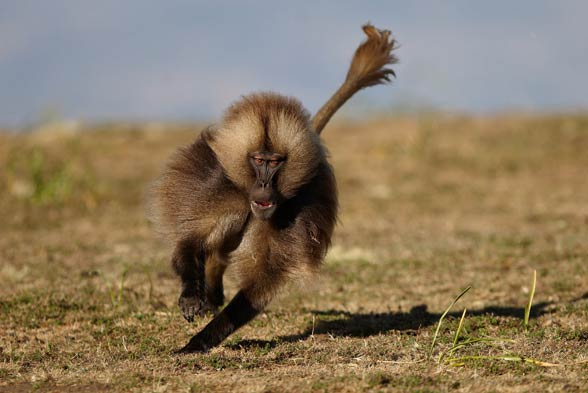
Reproduction
The reproductive period does not have a strict time frame. In some areas, the reproductive peak falls in May. At this time, the females present their rumps to the males, and then the males respond to the courtship. Females can copulate about 5 times a day.
Most births take place at night. Newborns have red faces, closed eyes, and their body is covered with black hair. Pregnant females and those, which are giving birth, are at the time outside the reproductive cycle. Other females may be interested in juveniles and even … kidnap them.
For the first 5 weeks, the mother carries its offspring on its belly, then it rolls on its back. After about 5 months of life, a small gelada can move on its own. A male from the reproductive age may share some of the care responsibilities of a young when it reaches 6 months.
Males reach puberty at the age of 4 or 5 and start reproducing only after taking domination over a group of females, which is around the age of 10. The females mature after about 3 years, although they start reproducing a year later.

Detailed data / dimensions
Gelada (Theropithecus gelada)
- Body length without tail: 50 – 75 cm (19.7 – 29.5 in)
- Tail length: 30 – 50 cm (11.8 – 19.7 in)
- Weight:
- males on average: 18.5 kg (40.8 lb)
- females on average: 11 kg (24 lb)
- Lifespan: 19 – 20 years

Gelada – curiosities
- The name Theropithecus comes from the Greek term for “terrible monkey” or “monkey-beast”.
- The closest relatives of the geladas are baboons.
- Gelada is able to chew plants as effectively as the zebra.
- The level of complexity of the sound emitted by geladas is close to human.
On the basis of the observations of wild specimens, it has been shown that these monkeys are able to “betray” its partner. However, if the dominant male learns about it, he will punish both the unfaithful partner and the male rival. This is the first case of wild monkeys which may cheat its partner and displays fear of being caught.






